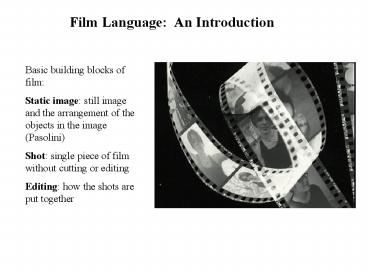Film Language: An Introduction - PowerPoint PPT Presentation
1 / 28
Title:
Film Language: An Introduction
Description:
WIDE ANGLE LENS. MASKED FRAME. COMPOSITION. Proportion and balance ... rhythm of cutting depends on camera distance: long shot=long take, medium shot ... – PowerPoint PPT presentation
Number of Views:308
Avg rating:3.0/5.0
Title: Film Language: An Introduction
1
Film Language An Introduction
Basic building blocks of film Static image
still image and the arrangement of the objects in
the image (Pasolini) Shot single piece of film
without cutting or editing Editing how the shots
are put together
2
ASPECT RATIO
3
ASPECT RATIO
1.531 aspect ratio
1.331 aspect ratio (aka 43)
Wide angle lens (left) and fisheye lens (above)
4
MASKED FRAME
5
COMPOSITION
Proportion and balance -size of figures and
relation of figures/objects to each
other -symmetrical or asymmetrical -centered/decen
tered -rule of thirds
6
COLOR
- Shots from Zhang Yimous Judou
7
COMPOSITION
Exposure -overexposed vs. underexposed
8
LIGHTING
-direction of light (back, fill, key
lighting) -focused or diffuse (high-key or
low-key lighting)
Above high-key lighting below low-key light
Above Three point lighting
9
FOCUS
sharp focus
soft focus
10
FOCUS
deep focus
shallow focus
11
RACKING FOCUS
changes the focus from one object to another
12
DEPTH OF FIELD
The extent to which the space represented is in
focus
13
SHOT SCALE
extreme long shot
long shot
medium long shot
close-up
medium close-up
extreme close-up
14
ANGLE OF CAMERA Tilt
Low angle shot camera tilted up
Tatami shot typical of Ozus films
High angle shot camera tilted down
15
ANGLE OF CAMERA pans and rolls
Pan
16
TRACKING SHOT
17
EDITING MONTAGE SCHOOL
-developed by Soviet filmmaker Eisenstein in the
1920s -juxtaposing two different shots to
generate a third meaning -fast editing of
disparate images to create a whole mood -Odessa
steps sequence from The Battleship Potemkin
Sergei Eisenstein (1898-1948)
18
EDITING CONTINUITY EDITING
-developed in Hollywood -editing that attempts
to economically ensure narrative
continuity -smooth flow from shot to
shot -figures balanced from shot to
shot -lighting consistent from shot to
shot -rhythm of cutting depends on camera
distance long shotlong take, medium shotmedium
take, close-upshort take
19
SHOT-REVERSE-SHOT
20
ESTABLISHING SHOT
21
EYELINE MATCH
Shot B what it being looked at
Shot A the looker
22
PARALLEL EDITING, or CROSS-CUTTING
23
LONG TAKE
- shots can last from 1 frame to an entire film
- Hollywood tends toward shot shots with fast
pacing - some art film directors prefer longer shots,
called long takes (to distinguish from a long
shot) - the long take creates a slower pace
24
AVANT-GARDE
Jump cut An elliptical cut that appears to be an
interruption of a single shot. Either the
figures seem to change instantly against a
constant background, or the background changes
instantly while the figures remain constant.
-seems to disturb the temporal and spatial
organization of the film Crossing 180 degree
line
25
PUNCTUATION
abrupt cutting (e.g. Eisensteins
montage) Dissolve one image gradually
superimposes over another, the latter fades
out Fade out usually indicates a long time
elapsing Iris a scene disappears or appears
like a iris shutting or opening Wipe line runs
through the screen replacing one image with
another
26
SOUND AND MUSIC
diegetic sound sound that is part of the
realistic world of the film extra-diegetic sound
sound that is added, in particular music (but
music can also be diegetic) speech natural vs.
artificial, colloquial vs. elevated, dialect vs.
standard, etc. Music creates a mood that can
radically change the way we see an image
27
NARRATIVE STRUCTURE
-how are all the shots put together into a plot
line -draws from many dramatic and literary
traditions -temporal organization duration,
frequency, and order -perspective objective or
subjective
28
GENRE
-closely tied to narrative -the genre a film is
working in determines to a large extent the
structure and style of the film -examples
western, erotic thriller, horror, love story
each has its own conventions -of course,
filmmakers can stretch the conventions or play
with them






























![Introduction to Biopsychology [PSB 4002] PowerPoint PPT Presentation](https://s3.amazonaws.com/images.powershow.com/6377876.th0.jpg?_=20150404023)
